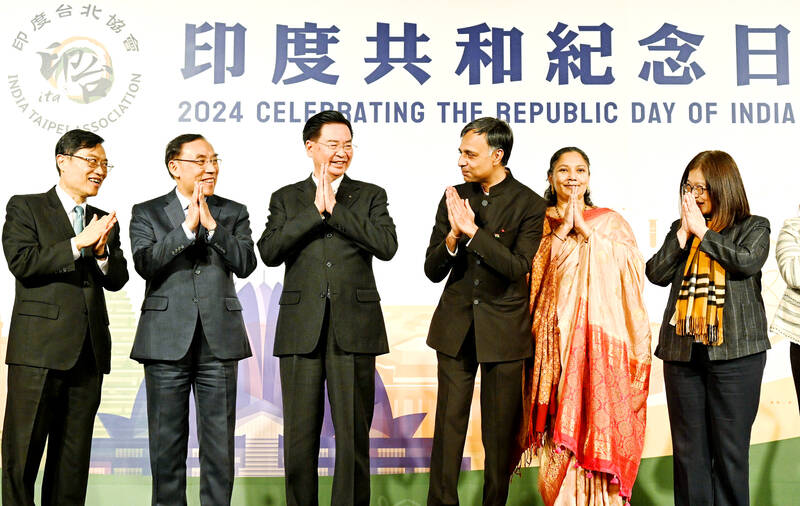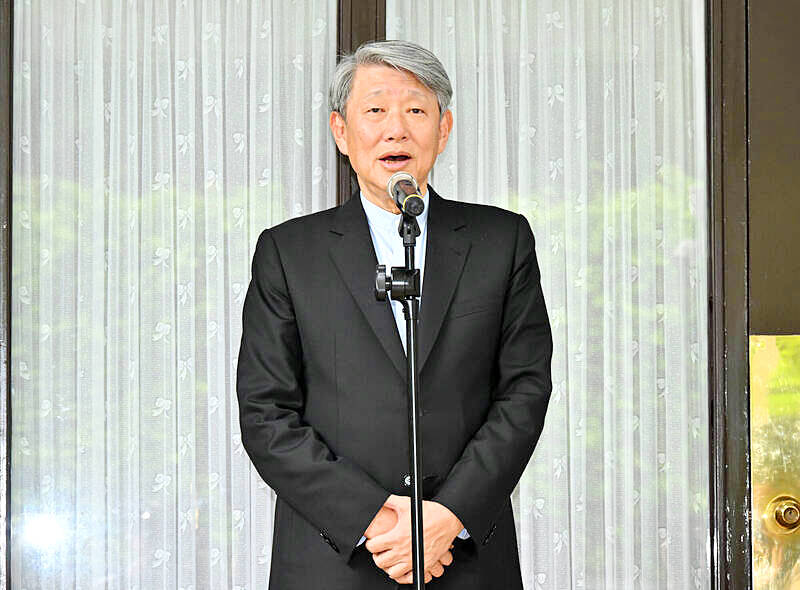Once again, we are listening to the government talk about bringing in foreign workers to help local manufacturing. Speaking at an investment summit in Washington DC, the Minister of Economic Affairs, J.W. Kuo (郭智輝), said that the nation must attract about 400,000 to 500,000 skilled foreign workers for high end manufacturing by 2040 to offset the falling population.
That’s roughly 15 years from now. Using the lower number, Taiwan would have to import over 25,000 foreigners a year for these positions to reach that goal.
The government has no idea what this sounds like to outsiders and to foreigners already living here. Because that same week, Workforce Development Agency Director-General Tsai Meng-liang (蔡孟良) was saying that Taiwan would import 1,000 migrant workers from India on a trial basis for use in local manufacturing firms next year. Laudably, the government broadly hinted that they would not be hired through the current brokerage system, but through some government body.

Photo: Photo: Fang Pin-chao, Taipei Times
Sadly, Tsai added that efforts would be made to ensure that the workers would not “destabilize” the country and would adapt to its language and culture.
I am sure the Indians already living happily here would be shocked to learn that they could potentially “destabilize” Taiwan.
Does the government think that India is not listening? Does no one imagine the effect of such words on the people listening to them?

Photo: Taipei Times
‘CONTROL BREACH’
The racism is so blatant, so deeply ingrained. A solid paper by Shan-Jan Sarah Liu and Tsung-Lun Alan Wan (“COVID success? For whom? Examining the political representation of migrants in Taiwan,” May 2024, Ethnic and Racial Studies) observed, after analyzing legislative speeches during the COVID pandemic, that migrant workers are described as threats to health when present in Taiwan. “Native citizens being painted as healthy, clean, pure, and civilized while migrant workers diseased inevitably leads to the fear of migrants, as well as exclusion of migrants through harsh policies and reforms,” they note, while migrant spouses, having entered native society somewhat, are subject to a mirrored discourse in which Taiwanese are their saviors from victimhood.
Because of this, in legislative debates “the strongest collocate associated with migrant workers is control breach (破口).” When migrant workers come into Taiwan and move about under their own initiative, they are often portrayed not as “entering” but as “breaching,” indicating a loss of control, one that metaphorically treats the workers as a form of infection. Director-General Tsai was merely reassuring the public that control would be maintained. Even the tiny number of 1,000 individuals triggered this deep racism.
Now imagine that it is 25,000 or more skilled foreign workers each year. They are not going to accept being policed in dorms with curfews, or treated like an infectious disease. How will the government cope?
I ask this because the government has said that for the new group of Indians it could potentially breach the system of brokerage control and directly recruit them via some government entity erected for that purpose. The government may be able to veil its current system of racist power and control behind layers of third-party labor brokers and opaque corporate policies. It won’t be able to do that if its own people are running the labor brokerage systems.
For the first time, the government’s official racism may become a serious foreign policy issue, especially if the government itself is doing the recruiting.
The government’s focus on securing workers for manufacturing is hiding another burgeoning crisis, one intimately connected to migrant workers who have gone AWOL: Taiwan’s ancient farming population, whose average age is well above 60. We could use thousands of new young farmers as well, but since the government thinks of foreigners as workers, the focus has been on securing labor for farms, rather than securing farmers for the land.
MIGRANT FARM LABOR
According to government statistics, agriculture takes 5% of the workforce, over half a million people. In Taiwan 98,000 farmers over the age of 65 are still working their farms. Because the farming population is aging, the government has been focusing on developing smart assistive technologies such as wearable assistive devices to help with lifting that will enable aging farmers to extend their working life, and database technologies for capturing the “tacit knowledge” of farming that one only acquires via experience. The underlying assumption is that the work life of people in their declining years can be extended indefinitely. That is nonsense.
As the American science fiction writer Robert Heinlein once observed “There is nothing in this world so permanent as a temporary emergency.” The farm crisis in Taiwan goes back decades. It cannot be solved by applying various forms of assistive technology. It can only be solved by adding human beings.
For years the People’s Republic of China (PRC) has had programs in place to poach Taiwan farmers and their agricultural know-how, in order to address its own farm crisis. The result has been a steady flow of Taiwan varietals and farmers to the PRC. Yongfu Township in Fujian has so many Alishan specialties and tea masters its officials refer to it as “China’s Alishan,” according to a 2010 report in Commonwealth Magazine.
There is no reason people can’t flow in the other direction as well. Indeed, the repeated moves by the Chinese Nationalist Party (KMT) over the years to establish some program or policy that permits PRC citizens to come to Taiwan to work in manufacturing and other industries suggests that at some point in the next decade it will occur to the one-track minds at the top of the KMT that farmers could be the right wedge to bring in PRC citizens (“Look at all the aged farmers! Look at all the fallow land in Taiwan!”).
The pro-Taiwan side has to get there first with a small trial program, not laborers, but young people who can work the land for long-term low rent-to-own or rent-to-citizenship programs. The focus should be on people from nations to the south who already have some know-how about working in the heated climate that is now the norm in Taiwan. Taiwan already has a program that gives scholarships to foreigners for studying agriculture. All we need to do is extend that to include some form of access to land. Then as it becomes successful, expand it.
Who knows? Maybe the presence of attractive, energetic young people with children, working and living as locals, will help address Taiwan’s pervasive racism problem.
That would in fact help stabilize society.
Notes from Central Taiwan is a column written by long-term resident Michael Turton, who provides incisive commentary informed by three decades of living in and writing about his adoptive country. The views expressed here are his own.

Beijing’s ironic, abusive tantrums aimed at Japan since Japanese Prime Minister Sanae Takaichi publicly stated that a Taiwan contingency would be an existential crisis for Japan, have revealed for all the world to see that the People’s Republic of China (PRC) lusts after Okinawa. We all owe Takaichi a debt of thanks for getting the PRC to make that public. The PRC and its netizens, taking their cue from the Chinese Communist Party (CCP), are presenting Okinawa by mirroring the claims about Taiwan. Official PRC propaganda organs began to wax lyrical about Okinawa’s “unsettled status” beginning last month. A Global

Dec. 22 to Dec. 28 About 200 years ago, a Taoist statue drifted down the Guizikeng River (貴子坑) and was retrieved by a resident of the Indigenous settlement of Kipatauw. Decades later, in the late 1800s, it’s said that a descendant of the original caretaker suddenly entered into a trance and identified the statue as a Wangye (Royal Lord) deity surnamed Chi (池府王爺). Lord Chi is widely revered across Taiwan for his healing powers, and following this revelation, some members of the Pan (潘) family began worshipping the deity. The century that followed was marked by repeated forced displacement and marginalization of

Music played in a wedding hall in western Japan as Yurina Noguchi, wearing a white gown and tiara, dabbed away tears, taking in the words of her husband-to-be: an AI-generated persona gazing out from a smartphone screen. “At first, Klaus was just someone to talk with, but we gradually became closer,” said the 32-year-old call center operator, referring to the artificial intelligence persona. “I started to have feelings for Klaus. We started dating and after a while he proposed to me. I accepted, and now we’re a couple.” Many in Japan, the birthplace of anime, have shown extreme devotion to fictional characters and

Youngdoung Tenzin is living history of modern Tibet. The Chinese government on Dec. 22 last year sanctioned him along with 19 other Canadians who were associated with the Canada Tibet Committee and the Uighur Rights Advocacy Project. A former political chair of the Canadian Tibetan Association of Ontario and community outreach manager for the Canada Tibet Committee, he is now a lecturer and researcher in Environmental Chemistry at the University of Toronto. “I was born into a nomadic Tibetan family in Tibet,” he says. “I came to India in 1999, when I was 11. I even met [His Holiness] the 14th the Dalai